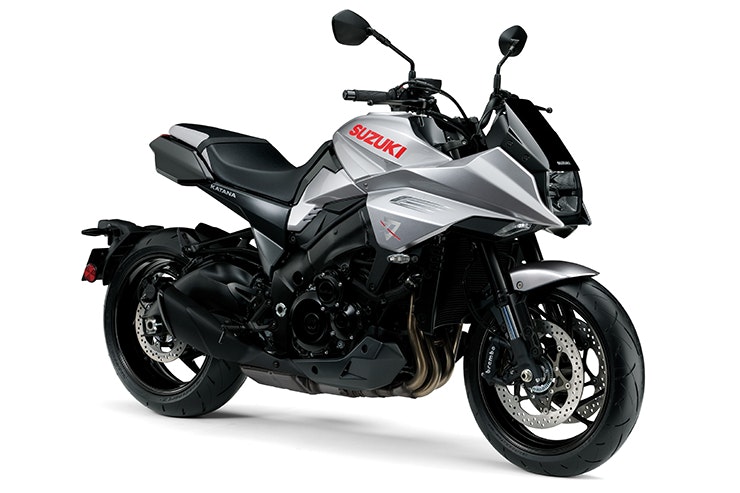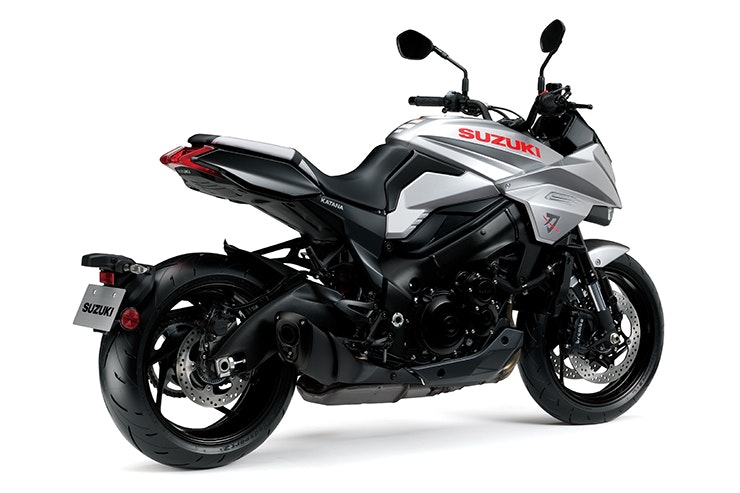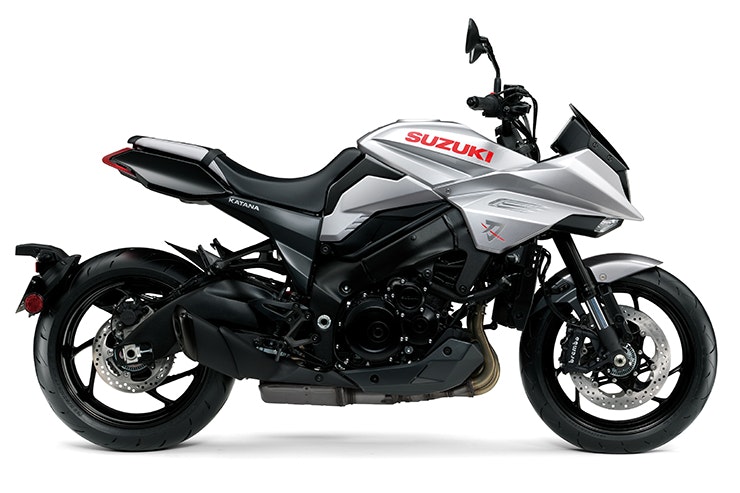Suzuki Katana (2019-2021): Review & Buying Guide
By Jon Urry
Massively experienced road tester
14.05.2024
£6,500-£8,500
147.9bhp
215kg
3/5
Released in 2019, the Katana appeared at a time when Suzuki were well and truly in the doldrums. Lacking any new models while development of their all-new parallel twin motor was underway, the Katana attempted to ignite a bit of excitement in the brand by tugging on the nostalgia heart strings with memories of what was a ground-breaking (visually at least...) bike for Suzuki. If you aren’t a Katana nerd, here is why it is such a well-regarded name.
In 1980, Suzuki asked German company Target Design to come up with a radical concept model. Headed up by Hans Muth, the firm created two prototypes called ED1 and ED2 (with ED standing for European Design) and this led to Suzuki taking a GSX1100E as a base and using these styling cues, in 1981 they launched the GSX1100S Katana. Mad-looking, the Katana instantly gained a cult following and in 2019 Suzuki hoped that they would be able to tap into this love with the all-new Katana model. Which, true to the original bike, was basically just a GSX-S1000 with a bit of new bodywork slapped on...
Never the most popular of models, the Katana failed to really excite riders and very quickly became something of a lame duck as sales were very slow. Updated in 2022 using the new GSX-S platform (which is greatly improved), the original Katana is cheap in the used market and although far from fault-free, is worth considering as you get a lot of bike for your money. As long as you are prepared to reinvest some of that saving making it better...
It’s a good looking bike with a cool heritage
The inline four has lots of mid-range
The price is right
Poor tank range
Inherent GSX-S faults still remain
Dead-feeling brakes and harsh suspension
Suzuki Katana (2019-2021) Price
Originally costing £11,399, the Katana’s sales were so poor that dealers were forced to slash this, especially when the updated Katana arrived and there were still old models left unsold on showroom floors. Nowadays you can get a 2019 model for around £6500 if it has done a few miles (around 10,000) but pay between £6700 and £7000 and you can get one with less than 5000 miles on its clocks. Very few Katanas have covered much mileage (something to do with the fuel tank’s size, but more on that later...) and as they are generally a slow-seller, you can realistically expect to haggle a few quid off any price tag. Prices for the updated 2022 bike start at £9999 but again, they can be had for less.
Engine and Performance
Powered by exactly the same inline four as the GSX-S, the Katana makes a fairly healthy 147.9bhp with 79.6lb.ft of torque. However, despite being physically identical to the GSX-S’s motor, the Katana does have a slight trick up its sleeve (or more precisely in its throttle) that Suzuki introduced in 2019 in an effort to make its fuelling less abrupt...
The Katana has a throttle tube that instead of being oval where the throttle cables run is instead slightly elliptical in the first half of its travel, reducing the amount the throttle you receive in relation to the grip’s movement. It’s like a quick action throttle but in reverse – a slow action if you will. A bit of a bodge rather than a proper fix, this tweak was actually introduced to all GSX-S models in 2019 – not that Suzuki shouted about it. Does it work? Not really, but it is better.
While the Katana’s initially throttle pick-up is still quite abrupt, once you get rolling the engine is actually very good with bags of mid-range and a fairly smooth nature. There is a bit of a vibe but on a modern retro, this is easily chalked down as character and it isn’t too intrusive. If you like an inline four, the GSX-S’s motor is a good example of the breed and after an ECU re-map by a competent dyno house, is actually both very rapid and also relaxed to ride – although it is still quite thirsty. It’s a touch annoying that the TC isn’t angle-responsive but Suzuki’s system works well enough and it is nice that it can be deactivated easily via the switchgear if you want to play the fool. And it is also very solid.
The GSX-S motor is absolutely bulletproof, so when buying used you have nothing to worry about at all, especially considering most Katanas have very low mileages on them.
Suzuki Katana (2019-2021) Handling & Suspension
The Katana’s chassis is taken directly from the GSX-S and that means you get fully-adjustable forks and a shock with adjustable preload and rebound damping as well as Brembo four-piston calipers, all of which is a promising set-up. Sadly, the reality doesn’t live up to this promise and as with the GSX-S, it isn’t great and ideally needs a few quid spent on making it better...
As standard the Katana has quite a firm ride quality, something that highlights the shock’s poor damping and generally results in quite a harsh ride. On a smooth road it is a good handling bike, certainly more towards a secure roadster than a sharp-turning super naked, but assured and fun to ride briskly. However, introduce a few bumps and it can all get a bit unpleasant with the shock transmitting the forces very abruptly to your spine and the front end not brilliant. Spend a few quid on an aftermarket shock (about £500) and get the forks re-valved (assume £250) and after careful set-up by a professional suspension firm the bike is transformed and although still not overly sporty, is a good handling road bike. But it still won’t be one that stops overly well...
Suzuki seem unable to arm any of its bikes with decent brakes and the Katana’s stoppers are horribly dead-feeling as standard. A change of brake pads makes a big difference, and it is also worth considering updating the OE rubber lines for braided items. Just remember that as there is an ABS system involved, so it is a job best left to a professional as bleeding the ABS module can often require a special procedure.
As the Katana is such a new bike, there is little to worry about from its chassis but obviously do the usual checks for tyre wear, chain and sprockets life and any signs of crash damage. A few Katanas get resprayed, which isn’t ideal. Oddly (they were quite desperate...) in late 2019 / early 2020 Suzuki launched a ‘new’ Katana model – but it was basically just black paint as originally it only came in silver.
Comfort & Economy
Fuel economy is a bit of an issue on the Katana as while Suzuki claimed it would do 53mpg, owners report that 45mpg is more common if you take it easy and 40mpg if you are going a bit more enthusiastically. Why is this an issue? Well, Suzuki chopped the GSX-S’s 17-litre tank down to just 12-litres for the Katana, giving it a best-case (using Suzuki’s figures...) range of 138 miles and a more realistic 110-120 in real world riding. That’s pretty dismal and is a constant frustration to owners. But would you want to ride it any further?
In terms of comfort the Katana isn’t bad. Basically a naked bike, you can add a small screen to deflect a bit of wind but it’s not that effective. Treat it as a short-hop bike (which is all its tank allows!) and you will be ok.
Suzuki Katana (2019-2021) Equipment
The Katana came with the same electronics package as the GSX-S and that means three-level traction control, which can be deactivated, as well as ABS however none of the safety assists are angle-responsive. There is also Suzuki’s Easy Start system and low-rpm assist, not that they are really worth shouting about. When the bike was launched, you could order it with the Samurai Pack, which cost an additional £999 and added a small fly screen, coloured seat, tank pad, carbon alternator and starter cover, carbon mudguard and a decal kit that included rim decals. It makes the bike slightly more practical but isn’t worth paying much extra for.
In the used market tail tidies are common alongside crash protection and loud exhausts but the only extras you really want to see are an updated fuel map done by a competent dyno house and an aftermarket shock, these really make a world of difference to how the bike rides and are much better investments than a loud can. And a set of new brake pads with braided lines is always good to see.
Suzuki Katana (2019-2021) Rivals
There are quite a few sporty retro bikes out there to choose from if you are after a nostalgic ride.
Honda CB1000R (2018-2021) | Approx Price: £6500-£8500
143bhp/77lb-ft
212kg
Kawasaki Z900 RS (2017-current) | Approx Price: £6500 - £9000
109.4bhp/72.7lb-ft
215kg
Yamaha XSR900 (2016-2021) | Approx Price: £5800 - £8000
113.4bhp/64.6lb-ft
195kg
Suzuki Katana (2019-2021) Verdict
The Katana is a hard bike to really either recommend or suggest to avoid. If you like its styling and remember the original model fondly, this recreation ticks the right nostalgia boxes and has a thoroughly modern chassis and motor. But it is also fundamentally flawed and its terrible tank range and poor throttle response and shock do it no favours at all. Get a cheap one and you can easily sort the shock and fuelling but the tank range is just something you will have to learn to put up with. Overall, it’s an acquired taste – much like the original model from the 1980s!
If you’d like to chat about this article or anything else biking related, join us and thousands of other riders at the Bennetts BikeSocial Facebook page.
Suzuki Katana (2019-2021) – Technical Specification
| Original price | £11,399 |
| Current price range | £6500-£8500 |
| Capacity | 999cc |
| Bore x Stroke | 73.4mm x 59mm |
| Engine layout | Inline four |
| Engine details | Liquid-cooled, 16v DOHC |
| Power | 147.9bhp (110kW) @ 10,000rpm |
| Torque | 79.6lb-ft (108Nm) @ 9500rpm |
| Top speed | 140mph (est) |
| Transmission | 6-speed, chain final drive |
| Average fuel consumption | 40mpg |
| Tank size | 12 litres |
| Max range to empty (theoretical) | 110 miles |
| Reserve capacity | 22 miles |
| Rider aids | 3-level TC, ABS |
| Frame | Aluminium beam |
| Front suspension | 43mm inverted KYB forks |
| Front suspension adjustment | Fully-adjustable |
| Rear suspension | Monoshock |
| Rear suspension adjustment | Adjustable rebound and preload |
| Front brake | 2 x 310mm discs, four-piston Brembo radial calipers. ABS |
| Rear brake | 220mm disc, one-piston caliper. ABS |
| Front tyre | 120/70 – ZR17 |
| Rear tyre | 190/50 – ZR17 |
| Rake/Trail | 25°/ 100mm |
| Dimensions (LxWxH) | 2125mm x 830mm x 1110mm |
| Wheelbase | 1460mm |
| Ground clearance | 140mm |
| Seat height | 825mm |
| Kerb weight | 215Kg Wet |


